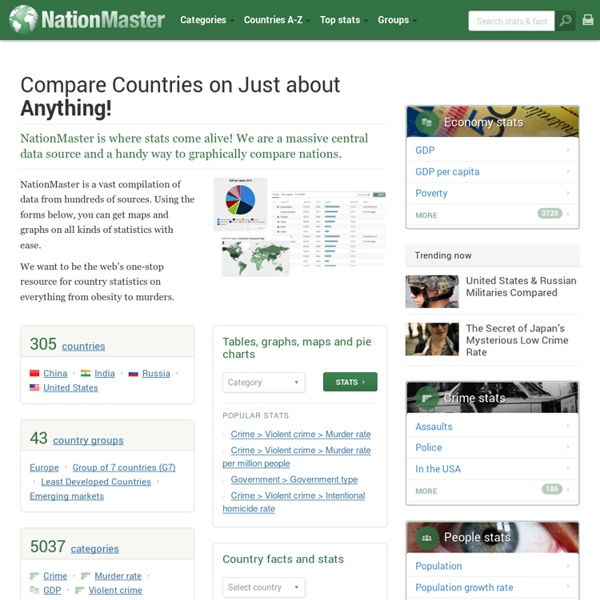



International fairs, tradeshows, trade shows, exhibitions, events What Causes Ocean Currents? The systems of ocean surface currents and deep water currents are, as expected, connected, but the locations of the physical connections are limited to three areas (one per main ocean), and are all on the Northern Hemisphere. The downwelling occurs on the Northern Atlantic, while the upwelling occurs on the Northern Pacific and the Northern Indian Ocean, as shown on the side map. The extents of the continental shelf block, or at least seriously limit, the movement of the ocean currents. To see a 3D view of the Conveyor Belt enlarge the diagram below. 1. 2. 3. 4. There is basically just one area on the global ocean where the ocean currents floating as the components of the Conveyor Belt system downwell, performing a radical dive and a switch of the direction.
• Statista - The Statistics Portal for Market Data, Market Research and Marke... Statistical Sites on the World Wide Web Skip to Content US Department of Labor A to Z Index | FAQs | About BLS | Contact Us U.S. Bureau of Labor Statistics Follow Us | What's New | Release Calendar | Site Map BLS Information Freedom of Information Act | Privacy & Security Statement | Disclaimers | Customer Survey | Important Web Site Notices Gapminder: Unveiling the beauty of statistics for a fact based world view.
You decide Australia's population, we'll show you how it looks Australia's population has more than quadrupled in the past century, with the number of people tipped to reach 25 million this year. If current trends continue the population will top 40 million within 40 years. Some say Australia should have stopped growing decades ago. Others point out Australia is a wealthy country with plenty of space to welcome more. This is your chance to decide how big (or small) you think Australia should be. The chart below shows 24 potential paths for Australia's future population, based on the latest projections from the Australian Bureau of Statistics. Keep in mind: a growing population means more demand on resources. How many overseas migrants should Australia have in the future? How many children do you have (or would you like to have)? Ideally, what age would you want to live to? Changed your mind? Welcome to your future Australia Based on your choices, Australia's population would reach 17,117,492 in 2101. So how does that compare to the year you were born?
Data.gov : US government open data MarketResearch.com: Market Research Reports and Industry Analysis Glossary of geography terms A[edit] absolute humidity The mass of water vapor in the atmosphere per unit of volume of space.[1] absolute location The location of a point on the Earth's surface that can be expressed by a grid reference such as latitude and longitude.[2] accessibility resource A naturally occurring landscape feature that facilitates interaction between places.[1] accessibility A locational characteristic that permits a place to be reached by the efforts of those at other places.[1] acid rain Rain that has become more acidic than normal (a pH below 5.0) as certain oxides present as airborne pollutants are absorbed by the water droplets. active volcano A volcano that is currently erupting, or one that has erupted during the last 10,000 years (the Holocene) or during recorded history.[3] agricultural geography air mass A very large body of atmosphere defined by essentially similar horizontal air temperatures. alluvia Clay, silt, gravel, or similar detrital material deposited by running water.[1] alluvial soils arête